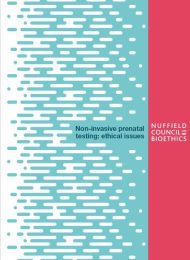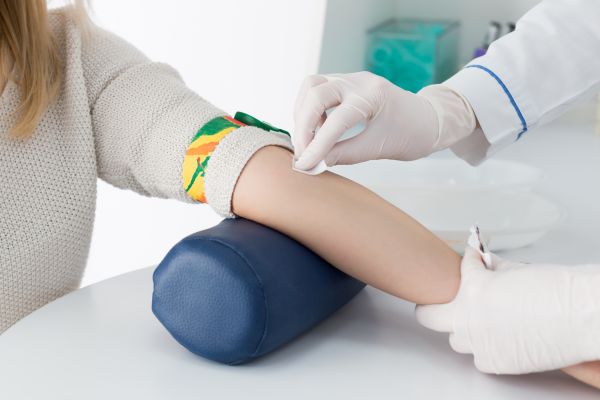Non-invasive prenatal testing: ethical issues
Report
Published 01/03/2017

Ethical values
The development and increasing availability of NIPT raises a range of ethical issues, some of which are similar to those raised by prenatal screening more widely. We propose that these can be broadly understood through consideration of the following ethical values.
Choice, autonomy and consent
Our ability to make free, informed choices about the medical tests and treatments we undergo is considered to be an important principle in modern healthcare. Reproductive autonomy refers to the capability men and women have to make choices about when they become parents, how many children they have and whether or not to make use of technologies such as prenatal testing.
NIPT can enhance or facilitate reproductive autonomy in different ways, including by enabling women and couples to prepare for a baby with a condition or trait, or decide to have a termination, potentially at an earlier stage of pregnancy.However, NIPT could also undermine autonomy and choice if accurate and balanced information about the test and the conditions being tested for is not available, or if women and couples feel they are expected to make a particular decision.
Avoiding harm
The Government has a duty to protect its citizens from harm. As part of this, it has a role to play in eliminating or reducing any harms that might be caused by healthcare interventions such as NIPT that are available through the NHS, or to consumers in the private healthcare sector.
Providing tests and treatments in publicly funded healthcare services that are safer, more effective and involve less discomfort than other available tests could be seen as a way of meeting these responsibilities. NIPT has the potential to reduce harms, for example where it can replace or reduce the need for invasive testing.
NIPT itself could also give rise to harms. For example, it could cause anxiety if the information and support provided to women and couples is inadequate or misleading, or where inaccurate or unreliable results are returned. If NIPT leads to a significant decrease in the number of people born with genetic conditions or impairments, it could lead to fewer resources being invested in research, healthcare and education relating to and available to people with genetic conditions, and cause offence, social exclusion and discrimination.
Equality, fairness and inclusion
It is generally accepted that the state has a duty to promote equality and work to ensure that all people are treated fairly. This involves taking into account how policies such as a new health intervention might reduce or worsen existing inequalities. It also entails the duty to ensure that public money is spent fairly.
NIPT has the potential to contribute to women’s ability to exert control over the circumstances of their pregnancies, with implications for their role in the workplace and wider society. Introducing NIPT into the NHS screening programme will mean that more women will have access to safer, more accurate prenatal testing.
However, NIPT has the potential to undermine equality, fairness and inclusion for disabled people in a number of ways. For example, it may give rise to perceptions that people are to blame for having a baby with a disability, and make disabled people and their families more vulnerable to stigma and abuse.
The Working Group’s ethical approach
The tensions that exist between the potential benefits of current and possible future uses of NIPT and the risks with which these uses are associated, create challenges for public policy. We suggest three general principles that, taken together, can provide a foundation for promoting reproductive autonomy and providing choice, while minimising potential harms and supporting an equal, fair and inclusive society.
PRINCIPLE 1: The wider societal environment in which NIPT is provided and developed should be considered when developing policy relating to NIPT.
We believe the state has a duty to promote an equal and inclusive society, and that wider social inequalities and injustices should be taken into account when policy, regulation and law relating to NIPT is developed.
Concerns about the inequality and challenges that disabled people face, for example in accessing adequate health and social care and support, educational and employment opportunities, are likely to influence the ways that women and couples think about their choices in pregnancy and prenatal testing. It is our view that women and couples will be better able to make genuine choices about their pregnancies if all disabled children are actively welcomed into the world and valued as equals to those without disabilities.
PRINCIPLE 2: Pregnant women and couples should have access to NIPT within an environment that enables them to make autonomous, informed choices.
When NIPT is offered to women and couples in the NHS, it will be important to emphasise that it is an optional test and that there are no expectations as to what is the ‘right’ decision.
In both the private and public sectors, it is important that accurate, balanced and nondirective information and support are made available to women and couples deciding whether to have NIPT, whether to have further testing, and whether to continue or terminate a pregnancy. High quality support must be available both to women who choose to proceed with pregnancies and to those who do not.
PRINCIPLE 3: Efforts should be made to reduce any risks of significant harms posed by the growing use and development of NIPT.
Action should be taken to minimise risks of harm resulting from the availability of NIPT.
For example, the use of NIPT to test for conditions where the accuracy of the test is unknown or poor can cause unnecessary anxiety for women and couples and may increase the number of women seeking invasive diagnostic testing.
Possible harms may also arise from extending the use of NIPT beyond testing for information that has a bearing on the immediate or early health of fetuses and future children. If, for example, NIPT could be used in future to test for less significant or adult onset conditions, or nonmedical features, this would raise concerns about the capability of future children and adults to make their own choices about accessing information relating to their genetic makeup and health, and to be able to access the same opportunities and services as those who do not have this information about themselves.
For more information, see Chapter 5 of the full report.

Share